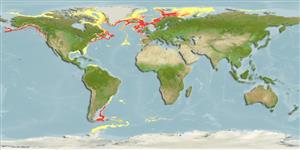Spiophanes kroyeri Grube, 1860
| Native range | All suitable habitat | Point map | Year 2050 |

|
| This map was computer-generated and has not yet been reviewed. |
| Spiophanes kroyeri AquaMaps Data sources: GBIF OBIS |
Google image |
No photo available for this species.
Classification / Names Common names | Synonyms | CoL | ITIS | WoRMS
Polychaeta | Spionida | Spionidae
Environment: milieu / climate zone / depth range / distribution range Ecology
Benthic; depth range 200 - 1500 m (Ref. 75621). Tropical
Distribution Countries | FAO areas | Ecosystems | Occurrences | Introductions
Northeast Pacific and Atlantic Ocean: North Sea and Central America to northern Brazil.
Length at first maturity / Size / Weight / Age
Maturity: Lm ? range ? - ? cm Max length : 3.0 cm TL male/unsexed; (Ref. 75621)
Life cycle and mating behavior Maturity | Reproduction | Spawning | Eggs | Fecundity | Larvae
Main reference
References | Coordinator | Collaborators
Salazar-Vallejo, S.I. 1996 Lista de species y bibliografía de Poliquetos (Polychaeta) del Gran Caribe. Anales Inst. Biol. Univ. nac. Autón, México, Ser. Zool. 67(1):11-50. (Ref. 7866)
IUCN Red List Status
(Ref. 130435: Version 2025-1)
CITES status (Ref. 108899)
CMS (Ref. 116361)
Threat to humans
Human uses
| FishSource |
Tools
More information
Max. ages / sizes
Length-weight rel.
Length-length rel.
Length-frequencies
Mass conversion
Abundance
Internet sources
BHL | BOLD Systems | CISTI | DiscoverLife | FAO(Publication : search) | Fishipedia | GenBank (genome, nucleotide) | GloBI | Gomexsi | Google Books | Google Scholar | Google | PubMed | Tree of Life | Wikipedia (Go, Search) | Zoological Record


